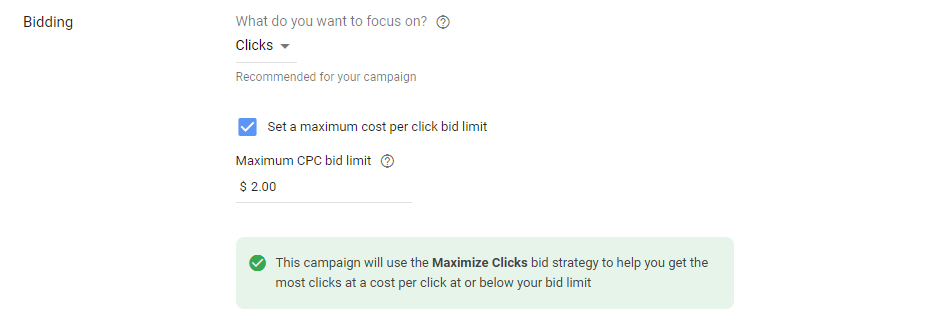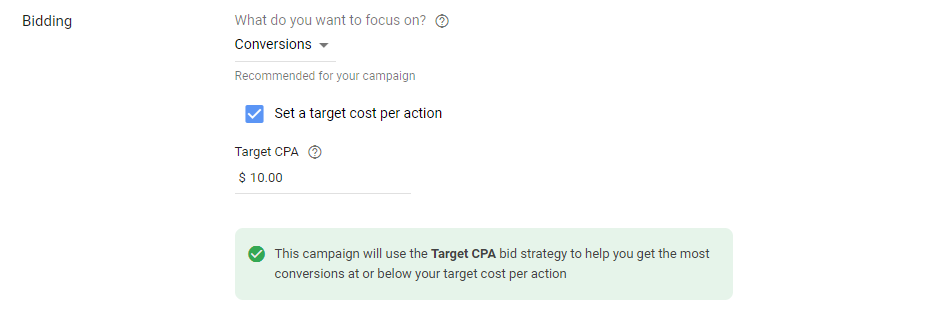
Subscribe to our newsletter!
We don't spam. You will only receive relevant and important tips for you and your business.
Unsubscribe anytime.
Mastering the art of bid strategies is nothing short of paramount. This guide will demystify the intricate world of Google Ads bid strategies. Whether you're new to the digital advertising or seeking to refine your existing approach, this resource is your compass to navigate through the complexities and make informed, strategic decisions.

We'll start by covering the basics of manual and automated bidding and how each is valuable depending on your campaign goals.
Choosing the right Google Ads bidding strategy can be difficult to do, but it is imperative to driving your ad costs down. If you don’t implement a solid strategy based on your account goals, you’ll end up paying more than you should.
Manual bidding requires you to set your own maximum cost-per-click (CPC) for your ads. Maximum CPC is the most you are willing to pay for someone to click on your ad. The higher you bid, the more clicks you’ll likely receive, but if you have a limited budget, it’s smart to be strategic.
You can adjust your bids at the ad group or keyword level, allowing you to reallocate your budget and spend more on keywords that perform well and less on those that don’t. This also allows you to increase bids on specific keywords and decrease bids on broad keywords that don’t result in as many conversions.
On the other hand, automated bidding sets each bid amount for you based on your business goal.
When setting up an automated bid strategy, all you need to do is set a maximum daily budget and Google will do the rest. Google Ads will raise and lower your CPC bids based on market fluctuations.
Some people may assume that automated bidding is the safer approach, however, if you’re new to Google Ads, it may be smart to start with a manual bid strategy. Manual bidding serves as preparation for more advanced bidding techniques. As an account grows in size, it becomes more difficult and time-consuming to manually manage. When an account becomes too large to manage, it’s time to switch to an automated strategy.
Automated bidding is able to maximize results for accounts with high conversion rates. These accounts are able to generate data that Google’s algorithm can use to make informed bidding decisions. However, if you don’t have enough volume, the algorithm doesn’t have enough data and can make the wrong calculations.
Automated bidding uses Google AI to set bids for your ads based on that ad's likelihood to result in a click or conversion. Automated bidding is a great choise if you're looking to increase:
This strategy let's advertisers set a goal impression share percentatge in the same way you set a target CPA for that bidding strategy. There are three placement options with Target Impression Share:
Each placement will tell the algorithm different things about your preferences and then adjust your bids accordingly.
Viewable CPM (vCPM) is a Display-only bid strategy and refers to the cost per thousand viewable impressions. An ad is counted as viewable when 50% of the ad shows on the screen for one second or longer for Display ads, and two seconds or longer for video ads.
This strategy is great for expanding brand coverage and getting your message in front of a large group of people.
Cost Per View is only available for video ads. With this strategy a campaign-level bid limit is set that implies the maximum you’re willing to pay for each view or interaction with your video (whichever comes first).
CPV is a great strategy for a hyper-focused campaign in competitive industries.
Before we jump into the smart bidding strategies, Smart Bidding is a subset of automated bid strategies that optimize for conversions or conversion value. Smart Bidding is not the same thing as Automated Bidding.
Smart Bidding refers to the strategies that use "auction-time bidding," which means they use machine learning to optimize for conversion or conversion value in every auction.
According to Google, Smart Bidding has three key benefits:
Smart Bidding strategies include:
Under the maximize clicks bidding strategy, you set a maximum daily budget. Google will then use this number to attempt to garner the most clicks as possible for your money.

Target CPA allows you to convert users at a specific acquisition cost.
With this method, Google Ads will automatically set your bids based on the price you’re willing to spend on acquiring one customer.
When determining your target CPA, your goal is to profit. For example, if you sell a product for $20, you don’t want to set your target CPA at $20. Instead, you may set your target CPA at $5, or an amount that allows you to make a sale without losing money.
When you select this strategy, you simply need to enter your target CPA, and Google will do the rest. If you choose a target CPA of $5, Google Ads will automatically set your bids to try to get you as many conversions at $5 on average. While some conversions may cost more, others may cost less to even out and align with your acquisition costs.
To help improve your performance, Google adjusts bids using real-time signals like device, browser, location, time of day, and more.

Target ROAS is an automated bid strategy where Google sets your bids to maximize conversion value based on the percentage return you want from your ad spend.
This bid strategy requires some math. To determine your ROAS, divide the amount you want to generate from ads by the amount you’re willing to spend and multiply this number by 100.
Sales ÷ ad spend x 100% = Target ROAS
Say you want to generate $50 for every $10 spent on your Google Ads campaign:
$50 in sales from campaign ÷ $10 ad spend x 100% = 500% target ROAS
To use Target ROAS bidding, you need enough data for Google’s machine learning to make informed bidding decisions. Most campaign types need at least 20 conversions in the past 45 days. Search campaigns need at least 15 conversions in the past 30 days. However, Google recommends that you have at least 50 conversions in the past 30 days.

Maximize conversions is one of the simplest bidding strategies that Google Ads offers.
Using the maximum daily budget that you set, Google will automatically run your bidding for you to get you the most conversions for your money.
To use this strategy, you simply have to enter your daily budget and Google will do the rest.

Enhanced CPC is only available on the Search and Display networks. Using this strategy gives Google the ability to raise or lower your bid amount based on the likelihood of driving sales.
If a search is too competitive and CPCs are high, Google will lower your bid due to decreased chances of converting. On the other hand, if it’s a likely sale, Google will increase the bid. Bids will try to be averaged out at your max cost-per-click settings.
Manual CPC allows you to completely control your bidding strategy. With this strategy, you can set bids for different ad groups or placements. If specific campaigns are more profitable than others, you can quickly increase or decrease bids.
While this strategy gives you complete control over your account, with it comes more time spent monitoring costs and adjusting bids.
You can also combine Manual CPC with Enhanced CPC bidding:

Doing this will still let you manually control budgets but allow Google to adjust bids based on the likelihood of converting.
When choosing a bid strategy, evaluate the campaign to determine if the strategy will help accomplish your goal and if you have enough data to make it work (e.g., do you have enough conversions so a Target CPA bid strategy can be effective?). If not, you might benefit from another bid strategy, a portfolio level strategy, or even an adjustment in account structure.
Need help deciding on a bid strategy?